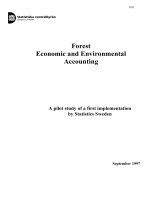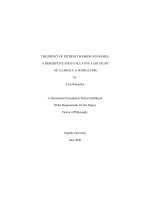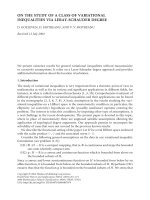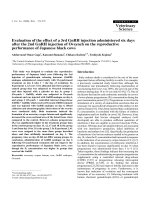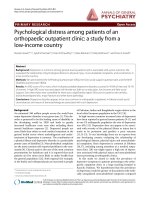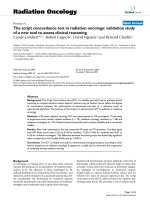study of a 3rd world country ethiopia
Bạn đang xem bản rút gọn của tài liệu. Xem và tải ngay bản đầy đủ của tài liệu tại đây (43.12 KB, 5 trang )
this is itPHYSICAL:Relief: Ethiopia consists mainly of Desert and
Mountains. Many valleys and plateau¹s also can be found in the country.
Due to these landform types the percentage of farm land is approximately
5.7% of the total amount of land in Ethiopia. The amount of arable land is
10% of the 5.7% total. Ethiopia has an area of 1 221 900 sq. km.
Ethiopia does not receive any problems such as volcanism, tidal waves,
etc., but it does receive great winds and monsoons. It is located in
Eastern Africa neighboured by Sudan (NW), Kenya(S), and Somalia(SE).
Elevations can be seen on figure 1, and the physical features of Ethiopia
on figure 2.Climate: The Climate in Ethiopia is of three different climatic
zones. These being the cool or dega zone, consisting of the central parts
of the western and eastern sections of the high plateaus and the area
around Harar, with terrains roughly above 7 900 ft. in elevation. The
second zone is the temperate, or weina dega zone, comprising portions
of the high plateau between 4 900 and 7 900 ft The final area being the
hot or kolla zone, encompassing an area with an altitude less than 5 000
ft. The cool zones temperatures and precipitation can be seen on figure
3. The temperate zones temperatures range from 15.6C to 29.4C. The
temperature in the hot zone of the lowlands can reach temperatures as
high as 60C.There are two distinct seasons in Ethiopia the rainy season,
or kremt, lasting from mid-June to mid-semptember. the other is the Dry
season, or bega, lasting from mid-September to mid-June. In April and
May there is slight transition period. The greatest amount of precipitation
is found in the southwest areas, near gore. They receive approx. 104 in.
a year. The littlest amount of precipitation is found in the Great Rift Valley
receiving less than 4 inches per year. the average annual precipitation in
the central plateau at 48 in.The prevailing winds that strike Ethiopia are
the Southwesterly monsoon in the rainy season and the northeasterly
wind from the Arabian Desert in the dry season.Ethiopia¹s climatic
conditions suffer severe drought jeopardizing millions with starvation.
These extreme weather changes create horrible growing seasons,
making yields quite unsuccessful.#Vegetation: The percentage of forest
land is minimal in Ethiopia, most of the area is grazed dry farmland, and
some generally arable land. Near areas where beef cattle are being
raised tsete flies can be found in great numbers. They spread a sleeping
disease, that in turn wear down farmers, and create less productivity, and
more disease than needed. Another insect that causes severe problems
are locusts. They are considered the plague of Ethiopia, eating, therefore
ruining crops. Due to lack of money Ethiopia does not have sufficient
preservation facilities, and much of there food rots and goes to waste.
Rodents also get into crops and eat whatever is at hand. Soils: Almost all
of Ethiopia¹s soils are made up of infertile red and yellow laterite. Humus
and other nutrients are washed out of the soils and into the rivers. Much
land is lost from erosion and desertification, from constant over grazing
and loss of trees.Wildlife: I couldn¹t find any information on Ethiopia¹s
wildlife, but I would suspect it is minimal. Small amounts of cattle and
ox.SOCIAL:Race: Ethiopia is quite unique for the number of races
throughout the country. These races are shown on figure 4.Languages:
In Ethiopia there are over 70 languages and 200 dialects spoken, but only
eight of the languages are commonly used. Amharic is the official
language of Ethiopia. Tigrinya and Arabic are the official languages of
Eritrea. These are the only three languages with a written script. Due to
the number of languages, many Ethiopians are bilingual and even
trilingual. See figure 4.Religions: Due to all these different religions
many problems arise, such as which religion should be the inferior
religion? Around 1931 Emperor Haile Selassie ruled. When the emperor
was overthrown the Ethiopian Orthodox Church lost its favoured position,
along with its lands and most of its property. Other religions, particularly
Western Protestant evangelical organizations, have found their activities
sharply curtailed by the government. this has been displayed through
closure of churches, seizure and nationalization of property and facilities,
and harassment and surveillance. Some religions have assembled
³secret areas² for worship and other #practices of there religion. See
figure 4.Population: The population in Ethiopia is extremely high, with a
vastly increasing birthrate. Forms of family planning are not used
steadily, if at all. The population can be seen in figure 5 and past and
future estimations of Ethiopia¹s population can be seen in figure
6.Housing and Clothing: Homes outside of the city are primarily made of
a mud/straw mixture. These homes obviously contain no electricity, or
insulation. All forms of heating would be done by man made fires, or
some form of wood stove. Due to the poor nature of the country nothing
else is affordable. Clothing consists of a loin cloth for men, and for
women some form of cloth is wrapped around the body. In the city
houses are typically made of cement with a tin roof. Here you may find
small amounts of electricity for heating and cooking, but nothing much
more. Some wealthy families may have a television etc. In the city most
people wear Western clothing.Diet: If the area is not getting foreign aid of
any sort the meals, if any, consist of a food called injera. This is a
pancake like sour bread of spongelike texture made chiefly with teff, a
cereal grain. Other foods include wat, a beef or chicken sauce or stew
made with hot spices. The universal drink is talla, a beer fermented from
barley, and the leaves of the gesho plant. Taj, a fermented honey
beverage, is consumed by the wealthier classes. Raw mature meat is
relished, but fish is not popular. Locusts are eaten by some cultures.
Many of the Ethiopian people are suffering from mass starvation.
reasons for the lack of food in Ethiopia are: Over Population, caused by
lack of use of family planning. 2.Poor Soils, most of the U.D.C.¹s have
infertile red and yellow laterite. 3.Variable Climates 4.Poor Distribution,
5.Food Destruction, 6.Tools and Technology: lack of proper farming
equipment, to obtain successful yields., 8. Ignorance, 9.Food Taboos,
10.Poor Seeds. These are only a few of the problems involved with lack
of food in Ethiopia. Unfortunately most of the quality food in Ethiopia is
grown by latifundia, and is exported to other countries.Jobs: Jobs are
very sparse, and if found, involve intense backbreaking work, at a minimal
cost. Due to the amount of unemployed people, practically any form of
work #thrown at them will be taken. Latifundia offer jobs to occupants,
such as coffee bean and cotton picking, and they pay them pennies an
hour. Some of these jobs are extremely far from home, breaking up
families for weeks. Others are self-employed farmers, or do not work at
all. Health: Health care in Ethiopia gets slightly better as years pass, but
still only a small portion of the population receives it. Famine care is
immensely small, and needs great improvement. The most commonly
found diseases in Ethiopia are malaria, tuberculosis, leprosy, venereal
diseases, smallpox, typhus, typhoid, trachoma, conjunctivitis, and
sexually transmitted diseases. Also see figures 7 and 8 for a further look
at health speculations.Education & Welfare: Education in Ethiopia is not
compulsory by law, but public education is free from the primary to the
college level. The schooling consists of 12 years divided into six years of
primary school, two years of middle school and four years of secondary
school. The literacy rate is extremely low at approx. 4.9% of the total
population. Literacy has been steadily increasing though in the past few
years. Ethiopia has been awarded the literacy price from UNESCO from
it¹s success. Further aspects of education can be seen in figure 9.In
Ethiopia there are no official welfare programs available. Existing public
programs are run by voluntary religious groups only. Due to this lack of
support, this is one reason for vast cases of starvation.Quality of Life:
The Quality of life in Ethiopia is horrible. There is a major shortage of
food, and very few jobs. Due to poor vegetation and soil, food growth is a
minimal. All work is usually backbreaking slave labour, and the main
priorities of an Ethiopian is survival.ECONOMIC:Development: Ethiopia
is a developing country. Its level of development is extremely poor and
slow, and isn¹t getting much better. Economy: Ethiopia continues to face
difficult economic problems as one of the #poorest and least developed
countries in Africa. Its Economy is based chiefly on agriculture and
weather plays a major factor in success rates. Development is slow and
doesn¹t look very promising. Manufacturing suffers from under
investment, shortages of raw material and poor management.Standard of
Living: The GNP of Ethiopia is 114 per capita, being extremely low, and
intolerable for any form of adequate survival. The level of living in turn is
substantially low. Urban Areas tend to be slightly better than rural, but
not by much.GNP insights can be seen in depth on figure 10.Industries:
The primary Industry of Ethiopia is Agriculture, employing roughly 85% of
the country¹s workers. The rest of the working population is broken down
to 10% in service industries, and the final 5% in manufacturing. The
products produced in the service industries and the manufacturing
industries can be seen in figure 11 and 12.Industrial Location: There are
approximately 8 main natural resources and 1 raw material found in
abundance in Ethiopia. This is shown in figure 12 and 13. Two thirds of
the power is provided through hydroelectricity, making Ethiopia one of the
least dependent on outside sources of energy in Africa. Ethiopia has two
narrow-gauge railways, two seaports, and National highways that connect
major population centers in the central plateau and Eritrea. This is only a
small portion of Ethiopia¹s transportation systems. Most of the country is
made up of unpaved or uncrossable roads, making transportation slow
and inefficient. The ratio of people to automobiles is 811:1. The labour
involved is monotonous and backbreaking. The people are paid pennies
for days work, and are usually situated in inadequate working facilities.
There are very few markets to purchase clothing etc Ethiopia¹s capital
is very low, and they do receive foreign aid and tariffs.Industrial Problems:
Ethiopia suffers a great deal, with environmental problems. Areas that
have been strip mined, grazed etc., have been left with no clean up what
so ever. In doing so the appearance of the area is very poor. Pollution
caused by heavy machinery is very low, because there isn¹t any, but
scrap and soot levels are high.There are no forms of pollution control,
and no pollution or dumping laws are enforced.#Agriculture: The
agricultural industry is extremely important to Ethiopia. It makes up 85%
of the jobs given to the people. Only 10% of the land area is currently
under cultivation, and it accounts for 47% of the GDP even though
drought, poor cultivation, and many other factors effect productivity. The
main types of crops grown are shown in figure 14. Most methods of
farming are done naturally, and traditional, by the sun and rain, or as
there ancestors before. Pesticides, Fertilizers, and Herbicides are too
expensive, and are used, if at all, in small amounts making them almost
useless. Most crops are planted manually, due to the lack of money.
Tools are handmaid, and ox are used for plowing fields. Only Latifundia
can afford efficient forms of harvesting, with expensive materials, and
machinery. There is no land distribution to any of the people. Most lands
are obtained through inheritance, from family members that have owned
it for generations. Education levels for agricultural techniques are very
low. All knowledge in farming is typically learned by ancestors, or by
³winging it². There is very little irrigation.POLITICAL: Form of
Government: Ethiopia is said to be a transitional government, but is also
known as a republic country. There current leader is Meles Zenawi. It is
a very unstable country that has had its share of civil wars, there last
leader was practically driven out of parliament. Elections don¹t really
exist. The people of Ethiopia are very limited with there rights and
freedoms. Ethiopia has been classified as a not-free country. There is a
very low value on human rights.Internal Conflicts: Ethiopia has had many
civil revolts. This can be seen in the Ethiopian History line, figure 15.
Many Ethiopians try to migrate to better there standards of living, in hope
of a brighter future. Most of the population is extremely poor, with the
odd family being better off. Most Ethiopians are considered lower class
citizens, that receive little respect if any.Trade: Ethiopia has about 7 main
imports and 5 major exports, that can be seen in figure 16. The balance
of trade is roughly -$617 000 000. The money they receive for there
exports is minimal. Exporting partners are: US, Germany, Djivouti,
Japan, Yemen, France, and Italy. There major importers are: USSR,
Italy, Germany, Japan, UK, US, and France. The stability of there
currency is unstable, and not very promising.#International Co-operation:
Ethiopia gives no aid to other countries, because it needs aid itself.
They receive foreign aid, from the US, Canada and other countries.
Food donations from the food bank, farmers, small organizations with
excess¹ of food, and other charity organizations donate a portion of items
each year. Many programs are also run where families ³adopt² a child. If
done a donation of money is sent to the country to give a poor child
blankets, clothes, and possibly a toy. Other organizations include the UN,
IRRA, and FAO.International Conflict: Ethiopia neighbours Sudan,
Somalia, and Kenya. Currently there are no border problems, but
attempts of migration are always present. Other border problems can be
seen in the history line of Ethiopia on figure 15.Future: All in all the future
of Ethiopia is very poor. Due to little or no family planning the birth rate is
still high. The inability to produce enough food for its vastly growing
population, still creates mass starvation. The government does not seem
to be planning any propositions of future hope, making chances of
improvement almost inevitable.#BibliographyColombo, John Robert, ed.
1996 Canadian Global Almanac. Toronto: Macmillian Canada
1996.³Ethiopia Famine.²Ethiopia: Case Study. Internet.
1996³Ethiopia.² Information Finder.
Vers.2.6. Computer Software. World Book, Inc., 1996Kurian, George
Thomas, ed. Encyclopedia of the Third World. New York: Facts on File,
1992Wright, Hohn W., ed. 1996 Universal Almanac, Kansas City: 1995
Universal Press Syndicate.
